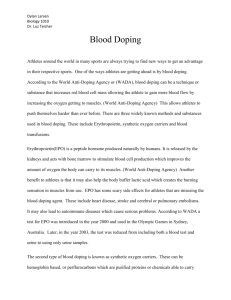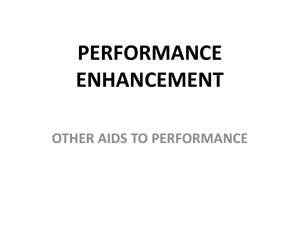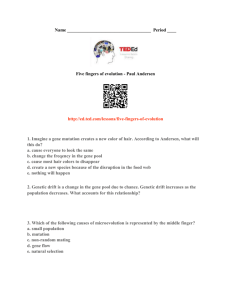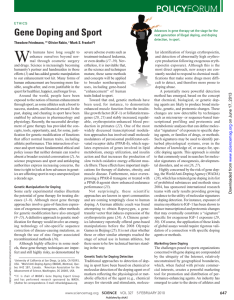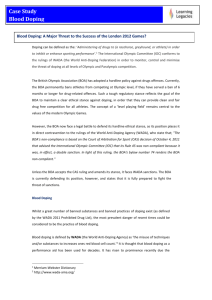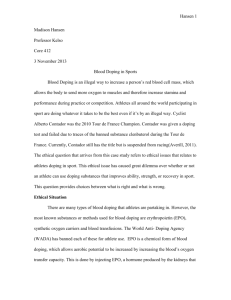A - Gene Doping - Club Humboldt do Brasil
advertisement
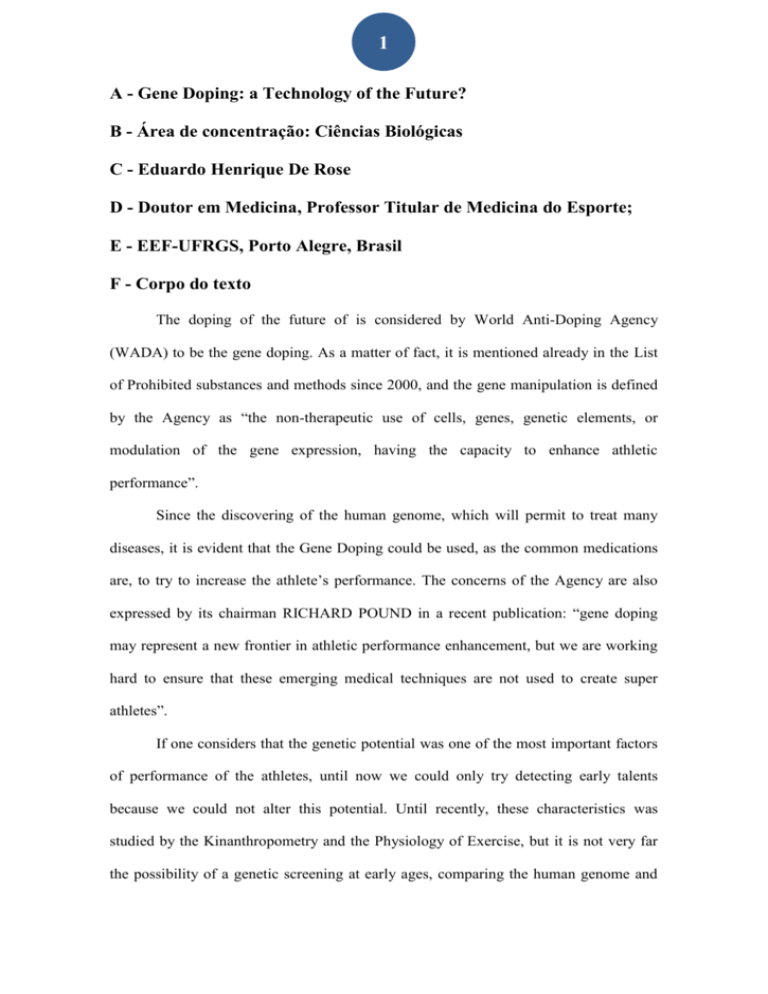
1 A - Gene Doping: a Technology of the Future? B - Área de concentração: Ciências Biológicas C - Eduardo Henrique De Rose D - Doutor em Medicina, Professor Titular de Medicina do Esporte; E - EEF-UFRGS, Porto Alegre, Brasil F - Corpo do texto The doping of the future of is considered by World Anti-Doping Agency (WADA) to be the gene doping. As a matter of fact, it is mentioned already in the List of Prohibited substances and methods since 2000, and the gene manipulation is defined by the Agency as “the non-therapeutic use of cells, genes, genetic elements, or modulation of the gene expression, having the capacity to enhance athletic performance”. Since the discovering of the human genome, which will permit to treat many diseases, it is evident that the Gene Doping could be used, as the common medications are, to try to increase the athlete’s performance. The concerns of the Agency are also expressed by its chairman RICHARD POUND in a recent publication: “gene doping may represent a new frontier in athletic performance enhancement, but we are working hard to ensure that these emerging medical techniques are not used to create super athletes”. If one considers that the genetic potential was one of the most important factors of performance of the athletes, until now we could only try detecting early talents because we could not alter this potential. Until recently, these characteristics was studied by the Kinanthropometry and the Physiology of Exercise, but it is not very far the possibility of a genetic screening at early ages, comparing the human genome and 2 the better conditions of genetic potential in each sport, what will permit to select and train better the athlete, according to their abilities. The use of viral factors to deliver a gene to the athlete is the most effective and also most expensive method to be used, although if compared against non-viral factors, have a higher toxicity and can produce an immune reaction, what may cause sometime a rejection. The non-viral factors are only effective locally, and in consequence have less general effects. They are easy to be prepared and have less risk of contamination. Today, we consider that gene doping may be a reality in athletes. Examples of that could be the production of the red cell through a genetically modified Erythropoietin (DynEPO) that may not be detectable by the urine test, the muscle hypertrophy in healthy subjects using the IGF-1, the blocking of Myostatin, and also the production of new vessels which should be useful as a methods to increase oxygen transfer in the tissues by athletes. It is possible to find in the literature three studies that clearly show this tendency. The Belgian Blue is a cattle race known to have a bigger muscle mass when compared to conventional cattle. Examining the expression pattern and sequence of the gene in normal and double-muscled cattle it was found a mutation within the myostatin gene and seems that myostatin is a negative regulator of muscle growth in cattle as well as mice. Viral expression of IGF-I without resistance training produced a 14.8% increase in mass. Combined with training of the will produced a 31.8% increase in muscle mass in mice. These results suggest that a combination of resistance training and over expression of IGF-I could be an effective measure for attenuating the loss of traininginduced adaptations. 3 Scientist from South-Korea and USA develop together a Marathon Mouse, a engineered mice that can ran 1,800 meters before quitting and stayed on the treadmill longer than the normal mice, that could run only 900 meters. The genetically engineered animal has been given an enhanced protein that turns it into an "endurance athlete" and makes it resistant to weight gain. Today, gene doping is still a question mark. Could it be stopped or the cells can multiply it selves causing diseases and later dead? May the immunological risk be uncontrolled and complicated the response of the body? The cell mutations can be or not transferred to the following generations? The medical, ethical and legal implications should, no doubt of that, still be previously evaluated by the physician and scientist that are dealing with such techniques. The Medical and Science Committee of the World Anti-doping Agency established a Gene Doping Panel in 2005, chaired by Prof. THEODORE FRIEDMAN, a pediatrician that is the director of the gene therapy program at the University of San Diego, USA. He believes that this technology is evolving very rapidly, considering that the science involved is not very difficult and can be performed by well-trained people in thousands of laboratories all over the world. Many scientists of the field believed that already in the Olympics of London it will be possible to have some degree of gene doping. Will be possible to detect gene doping? In my opinion, and in the opinion of many scientist of the area, the answer should be yes. If we revise the story of doping, the same question was made many times, and the answer was always yes. Anabolic were detected, testosterone included. Masking agency and hormones were also detected, as well as manufacture of synthetic of the anabolic steroids. If we invest enough grants 4 in research, and WADA is supporting many projects by now, I am sure that we will have detection when this kind of doping will reach our athletes. G - Bibliografia FRIEDMAN, T.; KOSS J. Gene transfer and athletes: an impending problem. Molec Ther 3:819-820, 2001. KAMBADUR, R.; SHARMA, M.; SMITH,T.P.L; BASS, J.J. Mutations in myostatin (GDF8) in Double-Muscled Belgian Blue and Piedmonts Cattle. Genome Research Vol. 7, No. 9, pp. 910-915, September 1997. LEE S.J., MCPHERRON A. Mighty Mouse John Hopkins Medical Institution - 1997 WANG, Y.X; ZHANG, C.L; YU, R.T; CHO, H.K., NELSON M.C. et all Regulation of Muscle Fibers Type and Running Endurance by PPARδ. Vol 2(10): e322, October 2004.


